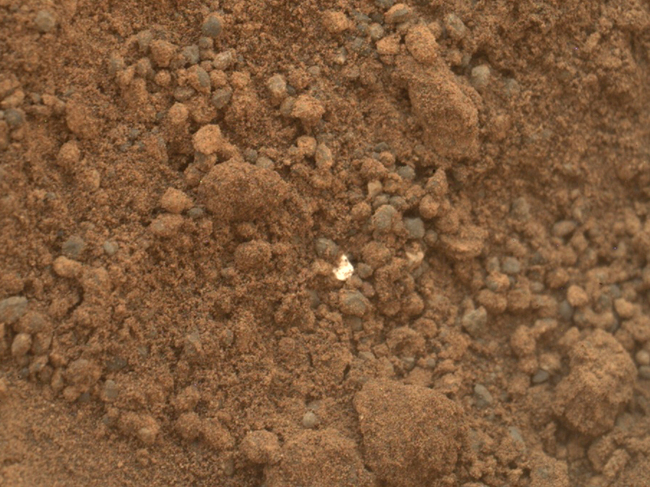
NASA's Mars rover Curiosity has swallowed its first solid sample into an analytical instrument inside the rolling laboratory, mission scientists said.
The rover's Chemistry and Mineralogy instrument, or CheMin, is analyzing the sample to determine what minerals it contains, NASA's Jet Propulsion Laboratory in Pasadena, Calif., reported Thursday.
"We are crossing a significant threshold for this mission by using CheMin on its first sample," Curiosity's project scientist John Grotzinger said. "This instrument gives us a more definitive mineral-identifying method than ever before used on Mars: X-ray diffraction.
"Confidently identifying minerals is important because minerals record the environmental conditions under which they form."
The sample, about as much material as an aspirin tablet, is from the third scoop collected by Curiosity at a patch of dusty sand called "Rocknest."
A future sample will be delivered to the rover's other internal analytic instrument, the Sample Analysis at Mars investigation, which studies samples' chemistry, JPL said.
Curiosity's two-year prime mission will see it using 10 instruments to assess whether the study area has ever offered environmental conditions favorable for microbial life, scientists said. (UPI)
<관련 한글 기사>
화성 표면서 정체불명의 물질 발견!
미국 항공우주국(NASA)의 화성 표면 탐사 로봇 큐리오시티가 마침내 흙 표본을 채취해 분석하기 시작했다고 MSNBC가 19일 보도했다.
NASA 관계자들은 큐리오시티가 최근 진행 경로에서 발견한 유난히 반짝이는 물체를 포함해 흙 한 줌을 떠서 화학분석기 `케민'(Chemistry and Mineralogy)에 투입했다고 밝혔다.
이들은 이 반짝이는 물체가 한때 추측했던 것처럼 큐리오시티에서 떨어져 나온 부스러기가 아니라 화성의 물질이라면서 이 때문에 케민의 분석 결과를 예의 주시하고 있다고 말했다.
화성의 토양 속에서 발견된 반짝이는 물체의 크기는 약 1㎜로 중간급 모래 알갱이 정도인데 앞서 근접 촬영 영상에서는 화성의 전형적인 흙이 아닌 것처럼 보였기 때문에 분석팀은 오염된 표본이 분석기에 투입될까 크게 우려했었다.
이 알갱이는 결국 화성 고유의 물질인 것으로 밝혀졌는데 분석팀은 이에 대해 두 가지 가정을 내놓고 있다.
첫째는 보통 화성 모래보다 햇빛을 더 잘 반사하는 표면이 형성될 때 떨어져 나왔을 가능성이고 두 번째는 이것이 일반 흙과 섞여 있긴 하지만 실제로 다른 것과는 다른 종류의 광물질일 가능성이다.
연구진은 케민과 켐캠(레이저 분석기)의 추가 분석결과를 종합해 이 물질의 정체를 밝힐 계획이다.
큐리오시티는 로봇팔의 끝에 달린 스쿠프로 떠낸 첫 번째 흙으로 내부 표면을 닦아냈고 두 번째 흙은 오염의 우려 때문에 사용하지 않고 버렸다.
큐리오시티는 세 번째로 떠 낸 흙을 흔들어 케민의 투입구에 넣었고 이 중 일부 가 분석기로 통하는 깔때기를 통과했다.
25억달러가 투입된 큐리오시티는 2년간의 활동을 통해 고대 화성이 생물체 서식 가능 환경이었는지 조사하게 되며 이 임무에서 화성 광물 분석은 중요한 과정이다.
연구진은 수십억년 전 화성이 지금보다 따뜻하고 물이 많았던 시절 토양이 지하 생물이 살 수 있는 환경이었을 가능성이 있다고 지적했다.
큐리오시티는 다음 주 표면분석장치 `샘'(Surface Analysis on Mars)에도 첫 시료를 투입할 계획이며 그 다음에는 처음으로 암석에 구멍을 뚫어 시료를 채취하게 된다.
핵연료로 가동되는 큐리오시티는 지난 8월5일 화성 표면에 착륙했으며 6개의 바퀴 중 일부가 약간 충격을 받긴 했지만 "건강 상태는 매우 좋다"고 운영팀은 밝혔다.


















